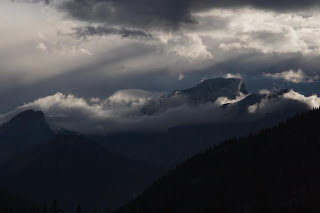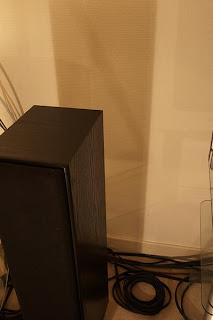 Receding sun, Alberta Rockies, September 2007
Receding sun, Alberta Rockies, September 2007Image is RAW converted as shot - still unsure where to go with this one
At last, this is part 2 of a 2 part review. Part 1 is here.
Brief note from the last part: nomenclature - 17-55/2.8 refers to the Canon EF-S 17-55 f/2.8 IS lens and 17-40 refers to the EF 17-40 F/4L lens (I get fed up typing all that stuff).
Part 2: Tests and comparison
This part is a little more technical as I try to get to grips with some of the apparent performance I observed in the 17-55/2.8. I set out to answer 2 questions:
1. Does the 17-55/2.8 carry more contrast in the shadows than the 17-40, especially with medium exposures (4-10s)?
2. Does the 17-55/2.8 have more mid-tone contrast in general shooting conditions (daylight etc)?
These questions came from my subjective view on the images I was creating with the 2 lenses under a variety of conditions, especially the top image from my recent Canada trip.
In brief, the answer to both questions is "no but it may appear so". Read on to find out why but first something completely different...
2a. Alignment
I was striving to make testing conditions as constant as possible for these 2 lenses. I was being careful to use the same exposures, same focus targets for the same scene with careful control of the focal length for content.
One of the first things that I noticed, however, was that the 17-40 was not focusing on the same spot, in fact it was looking a little above the 17-55/2.8. Odd, I thought - needs some investigation.
I carefully set up a comparison horizontal shot test to look at target offset. This was done by setting measuring the distance between 2 marks on a vertical wall that were targeted in the dead centre of the central focus point for each lens.
Result: the 17-55/2.8 targets 0.3degrees below the 17-40. This was constant across the zoom range. Reason: "slop" in the mechanism for the zoom. As the 17-40 is fully enclosed and doesn't extend it keeps optic plane constant. For the 17-55/IS, however, the zoom extension mechanism has some slight play in it, resulting in a slight tilt downwards. Good news if your a landscape photog, not so good news for the close-up, wide open crowd.
Getting to the nub of things...
2b. Shadow detail
Here's the test subject, shot under tungsten at ISO100 and f/8. 4-10s exposures.

Before getting to the results, a note on test protocol. When i first ran the test shots in Av mode I found that the 17-40 was metering about 1/3stop faster (lower exposure) than the 17-55/2.8. It was also returning different auto-WB values. While all shots were taken in RAW mode, the WB values were affecting the software views (I used both Canon and PhaseOne software). I reshot in manual with a fixed WB value (4000K here).
Result: no noticeable difference in the shadow contrast (colour values), even at 200% magnification. Noise was pretty constant and resolved detail was the same.
I re-ran the tests with this view (green curtains):

Same results.
One thing bothered me, though; the source of the colour balance and exposure differences. Leading to:
2c. Colour transmission & contrast
These things come together for a good reason, that should become apparent.
When I was looking at the previous results closer, especially examining the RGB histograms it was clear that the 2 lenses were giving different results. In the red channel, the 17-40 gives a top value of around 1-bit difference (assuming the software histogram scales are exponential) - i.e. half a "bar" on a 6-bar scale. For the green channel it is about 0.5-bit. Blue channels were identical.
Also linked to the, the R&G channels were definitely showing differences across the scale. The 17-55/2.8 was compressing the values as well as having a shorter tail at the high end (see image below).

 17-55/2.8 on left, 17-40 on right
17-55/2.8 on left, 17-40 on right Exposure histograms from PhaseOne Capture One. Same WB, same exposure for each lens
17-40 clearly shows greater range in both red and green channels
What does this mean? The 17-55/2.8 has a lot more latitude for an expose-right strategy. Maybe 0.5-stop. This leads to higher shadow values and more latitude for opening up the mid-tone. This is why my qualification on the answers to the questions. While the RAW results return more contrast from the 17-40, highlights can be blown or the shadows blocked. The 17-55/2.8 gives more room to expose right, thus opens the shadows without blowing highlights. It has clearly been coated to optimise for digital.
Final Conclusions
The 17-55/2.8 is a nicely put together lens, gives excellent results in terms of edge-edge sharpness. IS is really useful, to the limit of subject motion. It is optimised for digital, allowing expose-right to be better used.
That said, I prefer the handling of the 17-40. The lack of play in the mechanism means true parallel focal plane (although the slight tilt from the 17-55/2.8 will help in some circumstances). It's also lighter and smaller so better for hiking. With the advent of the new highlight priority mode, the issue with greater range in R&G should be improved. If you're an IR shooter, the reduced red transmission from the 17-55/2.8 may work against you.
For me, I will continue to use them as I intended. The 17-40 will be my outdoor hiking lens, I'll use the 17-55/2.8 for available light & interior architecture and as a general purpose travel lens.




No comments:
Post a Comment
I like comments, especially constructive ones.
Comments get emailed directly to me before publishing , so if you want to get in touch drop a comment.
All comments moderated by me before being published, keeps the spam at bay.